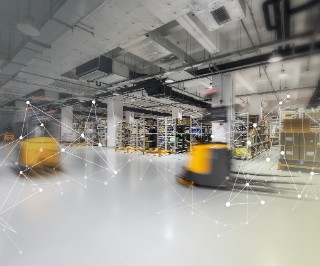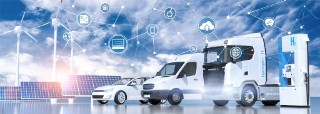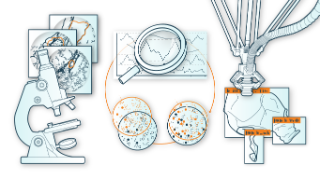Here you will find a selection of our projects.
At the ADA Lovelace Center, research and industry join forces to take methods and procedures in the field of artificial intelligence beyond the boundaries of what is currently possible.
more infoHere you will find a selection of our projects.

At the ADA Lovelace Center, research and industry join forces to take methods and procedures in the field of artificial intelligence beyond the boundaries of what is currently possible.
more info
The key feature of autonomous systems is that they use sensors to map their environment and can interact with it independently using actuators. For example, this paves the way for self-driving cars, robots that perform tasks autonomously, and systems that regulate themselves adaptively. Autonomous systems are made up of sensors for mapping the environment and components for the aggregation, analysis, and interpretation of data, as well as situation assessment, action planning, and actuators. A method known as deep reinforcement learning (DRL) is used to implement decision-making in autonomous systems or agents.
more info
Traction energy consumption is the primary cost factor in the electricity bills of rail transport companies, and is largely determined by how the trains are driven. Energy-efficient speed profiles can therefore lead to significant reductions in power consumption. This includes making the greatest possible use of coasting phases, during which the train consumes no energy. However, it is also vital to coordinate rail traffic with an eye to energy efficiency – for instance by avoiding excessive numbers of simultaneous departures, which result in high peak loads on the electricity grid and therefore additional charges. Moreover, it is important to synchronize arriving and departing trains so that energy recovered while one train is braking can be used to accelerate another.
more info
KI-Analysen von Satellitendaten machen Risiko- und Standortanalysen erheblich präziser, detaillierter und zuverlässiger.
The availability of land is the most important factor when it comes to developing major new business locations. In reality, however, municipalities and companies wishing to locate here are struggling with an increasing shortage of land, especially in metropolitan areas. In addition, for reasons of sustainability, the net new sealing of commercial areas is to be reduced, so that in many cases new settlements can only be realized by reactivating commercial areas that are no longer used, so-called brownfields. These have further advantages: they are often already connected to local supply networks, have good infrastructure links and are easily accessible for employees. But where are these brownfields located and how many do they actually have? And what legacy issues can be expected on site? While some municipalities have a detailed insight here, other regions up to federal states have only sporadic and decentralized information on this.
more info
As progressive automation brings us closer to autonomous systems, machine learning methods for mapping and processing complex and unknown situations have become indispensable. Autonomous systems with an advanced degree of automation – i.e., highly automatic to fully autonomous systems – often employ neural networks for context recognition. Early results in the field of deep learning appear highly promising for this task, enabling driverless vehicles to recognize objects, interpret traffic events and issue driving instructions. These techniques, which are based on machine learning, can either be used system-wide, that is from the sensor to the actuator, or merely to solve individual aspects of autonomous driving.
more info
In this project, an advanced neural network has been developed, specialized in predicting and minimizing casting defects in production processes. The main strength of the system lies in analyzing production data to detect errors early and generate optimization recommendations. This results in a significant improvement in production quality and efficiency by reducing scrap and material waste.
more info
In this project, an advanced neural network has been developed, specialized in predicting and minimizing casting defects in production processes. The main strength of the system lies in analyzing production data to detect errors early and generate optimization recommendations. This results in a significant improvement in production quality and efficiency by reducing scrap and material waste
more info
There are numerous commercial and open source tools on the market for ML solution development in the industry. However, the choice is complex due to application-specific constraints such as license agreements, data security and system compatibility. The integration of multiple tools for a specific functionality leads to challenges in usability, operability, maintenance and integration into the existing infrastructure. Fraunhofer IIS develops customized MLOps solutions for the supply chain that take into account the specific requirements of our industry partners. These solutions optimize the strengths of different ML tools while being easy to use and maintain.
more info
When it comes to preparing an inventory of entire vehicles, the automatic segmentation of three-dimensional datasets from X-ray computed tomography (CT) remains an unresolved challenge. Classical methods are unable to separate different parts and components into voxels and identify them with sufficient reliability. At present, this virtual »dismantling« process can only be performed manually, which is enormously expensive and time-consuming for the industry. There is, however, a great deal of interest on the part of industry, and strong demand for corresponding CT measurements there is an urgent need for solutions that can automatically break the data down into subgroups and convert the resulting volume images of individual assemblies into CAD-compatible formats.
more infoLearning with few data or few annotated data

Die bahnbrechenden Erfolge von künstlicher Intelligenz (KI) bei Aufgaben wie Spracherkennung, Objekterkennung oder maschineller Übersetzung sind u.a. auf die Verfügbarkeit von enorm großen, annotierten Datensätzen zurückzuführen. Annotierte Daten, auch gelabelte Daten genannt, enthalten die Label-Informationen, die die Bedeutung einzelner Datenpunkte ausmachen und sind essentiell für das Training von Machine Learning Modellen. In vielen realen Szenarien, besonders im Industrieumfeld, liegen zwar oftmals große Datenmengen vor, diese sind aber nicht oder nur wenig annotiert. Dieses Fehlen annotierter Trainingsdaten stellt eine der großen Hürden für die breite Anwendung von KI-Methoden im Industrieumfeld dar. Daher wird in der Kompetenzsäule »Few Labels Learning« das Lernen mit wenig annotierten Daten innerhalb von drei Schwerpunkten und verschiedenen Bereichen erforscht: Meta-Lernstrategien, Semi-supervised Learning und Datensynthetisierung.
more info
As a fundamental requirement for many applications in logistics and Industry 4.0, object positioning is an area in which Fraunhofer IIS has not only considerable expertise but also many years of experience. Applications frequently rely on radio-based positioning solutions, which typically measure the transit time of radio signals from mobile objects. To a large extent, the accuracy of the positioning system depends on the optimization of fusion and system parameters in different and sometimes changing environments. Fraunhofer IIS is therefore working to develop more robust positioning methods.
more info
At most companies, efficiency assessment of in-house transport using industrial trucks is performed manually, with sub-optimal results. We are tapping into this potential for optimization by developing »intelligence« for industrial trucks that enables analysis of individual intralogistics transport processes.
more info
The task of finding decisive – or otherwise interesting – scenes in the tracking data recorded during games such as soccer or ice hockey, evaluating them, and presenting potential solutions for situations that arise during the game, is a fundamental task for game analysis in sports clubs and associations, and for media coverage of sporting events. The current standard procedure involves manual entry of appropriate labels during a game, or time-consuming searches of video footage after the event.
more info
To achieve the climate goals of the Paris Agreement we must substantially eliminate fossil energy sources from our global economic system. For example, instead of using oil or gas for heating, mobility or electricity generation, a regenerative energy system needs to be established. However, there is a wide variety of applications that is difficult to be operated electrically because they consume too much energy, such as high-temperature processes in the manufacturing industry or heavy duty engines used in aviation, shipping or heavy goods transport. Even in the future most of these applications will rely on e-fuels.
more info
Every false move in manual order picking leads to extra work, but assistance systems that reduce the burden on pickers can be very complex to install. We are therefore developing a versatile wireless information system for order pickers as well as technology for the integrated validation of picking processes.
more info
When it comes to the subject of machine learning and deep neural networks (DNNs), there are usually more questions than answers, as data analysis by ML-based systems remains an enigmatic process for developers and users alike. Nevertheless, it is vital that the systems provide transparency and interpretability – particularly with regard to safety issues in the automotive sector, such as driver drowsiness detection, or in medicine, with automated screening of tissue samples. The use of automatic processes in critical strategic decision-making is dependent on the explainability of data analysis, which also underpins the general acceptance of these processes.
more infoUsage of Machine Learning methods despite poor database
Durch Digitalisierung und die stetige Entwicklung in der Erforschung von Künstlicher Intelligenz (KI), insbesondere im Bereich Machine Learning (ML), profitieren derzeit viele Unternehmen, indem sie neue datengetriebene Geschäftsmodelle entwickeln oder Prozesskosten senken können. Ein wichtiger Baustein für diese KI-Entwicklung ist das Vorhandensein einer großen Menge von qualitativ hochwertigen Daten. Few Data Learning kommt in Anwendungsbereichen zum Einsatz, in denen eine sehr kleine Datenbasis vorliegt: beispielsweise im Bereich der Bilderkennung, vor allem in der Medizintechnik zur Diagnose von Gewebeanomalien, für Computer Vision Anwendungen in der Bild- und Videoproduktion, oder für Prognose- und Optimierungsanwendungen in der Produktion und Logistik.
more infoLearning with few annotated data

Die bahnbrechenden Erfolge von künstlicher Intelligenz (KI) bei Aufgaben wie Spracherkennung, Objekterkennung oder maschineller Übersetzung sind u.a. auf die Verfügbarkeit von enorm großen, annotierten Datensätzen zurückzuführen. Annotierte Daten, auch gelabelte Daten genannt, enthalten die Label-Informationen, die die Bedeutung einzelner Datenpunkte ausmachen und sind essentiell für das Training von Machine Learning Modellen. In vielen realen Szenarien, besonders im Industrieumfeld, liegen zwar oftmals große Datenmengen vor, diese sind aber nicht oder nur wenig annotiert. Dieses Fehlen annotierter Trainingsdaten stellt eine der großen Hürden für die breite Anwendung von KI-Methoden im Industrieumfeld dar. Daher wird in der Kompetenzsäule »Few Labels Learning« das Lernen mit wenig annotierten Daten innerhalb von drei Schwerpunkten und verschiedenen Bereichen erforscht: Meta-Lernstrategien, Semi-supervised Learning und Datensynthetisierung.
more info